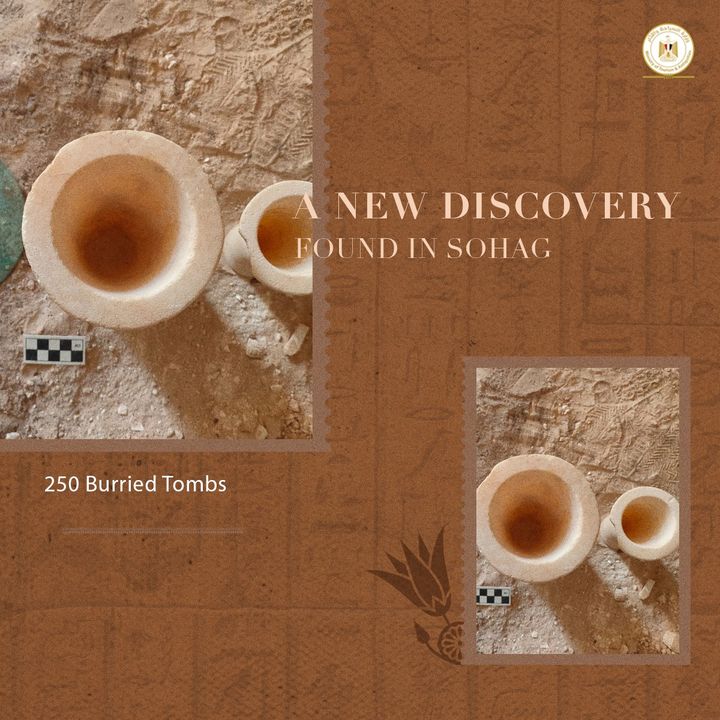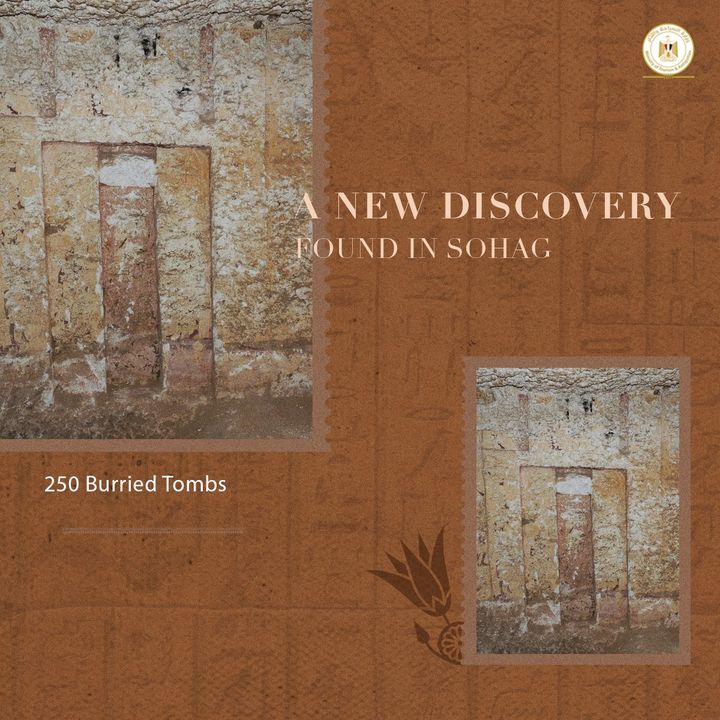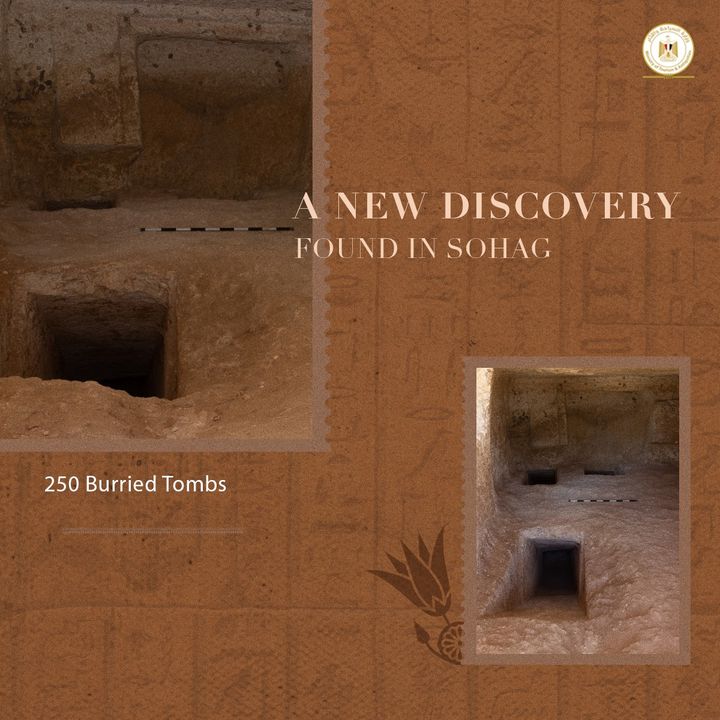في إطار مشروع التوثيق والتسجيل الأثري للمقابر الصخرية الموجودة بجبانة الحامدية بالجبل الشرقي بمحافظة سوهاج، نجحت البعثة الأثرية التابعة للمجلس الأعلى للآثار في الكشف عن عدد ضخم من المقابر الصخرية.
وقال الدكتور مصطفى وزيري الأمين العام للمجلس الأعلى للآثار، أن تلك المقابر ذات طرز متعددة يصل عددها إلى قرابة ٢٥٠ مقبرة محفورة في عدة مستويات في الجبل، ومنها مقابر ذات بئر أو عدة آبار للدفن، ومقابر أخرى ذات ممر منحدر ينتهي بغرفة للدفن. وتمتد تلك المقابر إلى فترات زمنية تتراوح بين نهاية الدولة القديمة وحتى نهاية العصر البطلمي.
وأشار إلى أن من النماذج المكتشفة للمقابر، مقبرة ترجع إلى نهاية الدولة القديمة مكونه من مدخل يؤدي إلى صالة عرضية وبئر للدفن بالجنوب الشرقي وهي عبارة عن ممر منحدر يؤدي إلى غرفة صغيرة للدفن، وتم إعادة استخدام البئر مرة أخرى في عصور لاحقة.
وأوضح د. مصطفي وزيري، أن تلك المقبرة تتميز بوجود باب وهمي عليه بقايا نقوش لكتابات هيروغليفية، بالإضافة إلى وجود بقايا لمناظر تخص صاحب المقبرة تصوره وهو يذبح الاضاحي، وأشخاص تقدم القرابين الخاصة بالمتوفي.
وقال محمد عبد البديع رئيس الإدارة المركزية لآثار المصر العليا، أن أعمال الحفائر في تلك الجبانه أسفرت ايضا عن الكشف عن العديد من الأواني الفخارية، بعضها كان يستخدم ضمن الحياة اليومية والأخر ضمن الأساس الجنائزي كودائع رمزية مصغرة وهي ما تعرف باسم ” votive miniature ” وهي أواني صغيرة الحجم على هيئة أواني كروية وعليها بقايا طلاء مصفر من الخارج، بالإضافة إلى العديد من الأواني المصنوعة من الالباستر صغيرة الحجم، والأواني الفخارية، وبقايا مرآة معدنية مستديرة الشكل، وبقايا العظام الآدمية والحيوانية، والعديد من كسرات الفخار التي تمثل الامفورات وترجع إلى العصر المتأخر، وبقايا قطع من الحجر الجيري عليها نقوش ربما تمثل لوحات جنائزية لأصحاب المقابر ترجع إلى نهاية الأسرة السادسة.
وفي إطار المشروع تم الانتهاء من تسجيل وتوثيق أكثر من ٣٠٠ مقبرة بالمنطقة والتي تمتد من نجع المشايخ جنوبا وحتى الخرندارية شمالا. و تمثل هذه المجموعة من المقابر حكام وموظفي الإقليم التاسع من اقاليم مصر العليا، والذي يعد من المراكز الإدارية الهامة في مصر القديمة نظرا لموقعة المتوسط بين العاصمة المنفية، وأسوان منذ الدولة القديمة، إلى جانب قربة من مدينة ابيدوس والتي تعد مركز عبادة الاله ”أوزير“، وكانت المركز الرئيسي للإقليم حاليا مدينة اخميم وكان المعبود الرئيسي للإقليم الاله ” مين“. ومن المتوقع مع استكمال أعمال المشروع أن يتم الكشف عن المزيد من المقابر في أكثر من مستوى بالجبل.
The discovery of several tombs in Al-Hamdiya necropolis east of Sohag.
As part of the archaeological documentation and registration project of the rock tombs in al-Hamdiya necropolis in the Eastern Mountain in Sohag governorate, the Archaeological Mission of the Supreme Council of Antiquities succeeded in uncovering a large number of rock tombs.
Dr. Mustafa Waziri, Secretary-General of the Supreme Council of Antiquities, said that these tombs have multiple models of about approximately 250 tombs etched at several levels in the mountain. They included tombs with a well or several burial wells and others with a ramp that ends with a burial chamber. These tombs date back from the end of the Old Kingdom to the end of the Ptolemaic period.
He pointed out that one of the models discovered is a tomb dating back to the end of the Old Kingdom that consists of an entrance leading to a cross-hall and a burial shaft in the south-east side, which is a sloped passage leading to a small burial chamber, and the shaft was reused again in later eras.
Dr. Mustafa Waziri explained that this tomb has an imaginary door with the remains of inscriptions of Hieroglyphic inscriptions, in addition to the presence of remnants of scenes belonging to the owner of the tomb depicting him slaughtering sacrifices, and people giving offerings for the deceased.
Mohammed Abdul Badia, head of the Central Department of Antiquities of Upper Egypt, said that the excavations in this area resulted in the uncovering many pottery pots, some of which were used in daily life and others in funerary furniture as miniature symbolic masterpieces, known as “vot” Miniature” which are spherical small pots with yellowish coating residues from the outside. They also discovered many small-sized alabaster pots, remnants of a round metal mirror, human and animal bone remains, and many pottery fractures representing the late-era amurs, and the remains of limestone pieces with inscriptions that may represent funerary paintings of the tomb owners dating back to the end of the sixth dynasty.
As part of the project, more than 300 tombs in the area, which extend from The Sheikhs Nag in the North, have been registered and documented. This collection of tombs represents the rulers and staff of the ninth province of Upper Egypt, which is one of the important administrative centers in ancient Egypt due to its position between the capital Manf, as well as Aswan since the old kingdom, in addition to its proximity to the city of Abidos, the center of worship of the God “Ozir”. It was also the main center of the city of Akhmim and the main God of the territory was “Min”.
He added that it is expected that more tombs will be uncovered on more than one level of the mountain.
Ministry of Tourism and Antiquities وزارة السياحة والآثار








